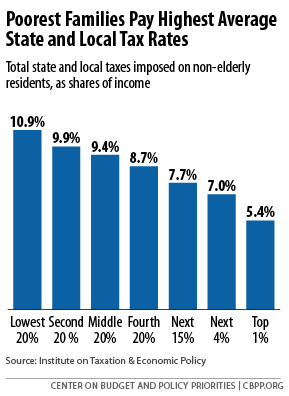off the charts
POLICY INSIGHT
BEYOND THE NUMBERS
BEYOND THE NUMBERS
State and Local Tax Systems Hit Lower-Income Families the Hardest
Receive the latest news and reports from the Center
In nearly every state, low- and middle-income families pay a bigger share of their income in state and local taxes than wealthy families, a new report from the Institute on Taxation and Economic Policy (ITEP) finds. As the New York Times’ Patricia Cohen wrote, “When it comes to the taxes closest to home, the less you earn, the harder you’re hit."

Only California taxes the top 1 percent of households at a higher effective rate (8.7 percent) than middle-income taxpayers (8.2 percent), ITEP found. In the ten states with the most regressive tax systems, the bottom 20 percent pay up to seven times as much of their income in taxes as their wealthy neighbors.
Washington State’s tax system is the most regressive, according to ITEP. The bottom 20 percent of taxpayers pay 16.8 percent of their income in taxes, while the top 1 percent pay just 2.4 percent. After Washington, the most regressive state and local tax systems are in Florida, Texas, South Dakota, Illinois, Pennsylvania, Tennessee, Arizona, Kansas, and Indiana.
A number of states, including Kansas, North Carolina, and Ohio, have made the situation worse in recent years by cutting income taxes, the only major state revenue source typically based on ability to pay. Income tax cuts thus tend to push more of the cost of paying for schools and other public services to the middle class and poor — exactly the opposite of what is needed.